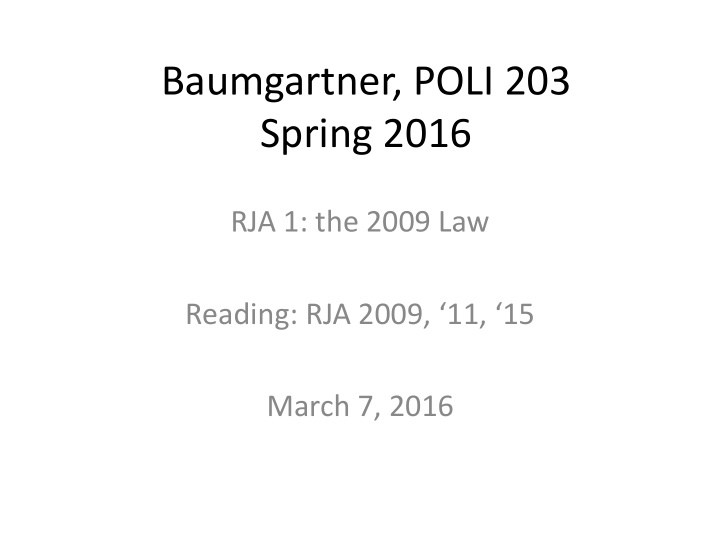



Baumgartner, POLI 203 Spring 2016 RJA 1: the 2009 Law Reading: RJA 2009, ‘11, ‘15 March 7, 2016
Catching Up • Last few slides we did not get to from last Wed. • Talk this evening: see class web page for 20 minute radio interview with Hidden Voices leaders about the presentation we are going to hear: – Chronological order from youth to death row – A mix of stories, edited and broken into pieces but the inmate’s own words – Actors will read the stories
Courts unresponsive to statistics • McCleskey v. Kemp, 1987 – Baldus study: review of all Georgia death-eligible cases, same as Donohue did for Connecticut (2,500 murders, 39 non-racial variables, killers of whites 4.3 times more likely to be sentenced to death in Georgia than killers of blacks) – (Attorney arguing the case before the USSC: Jack Boger, until recently the Dean of UNC Law School) • McCleskey v. Kemp: the Dred Scott of the 20 th century. Statistics don’t matter. Must prove “intent to discriminate” in the individual case. • McCleskey as the “bitter end” or a litigation strategy based on racial disparities – Huge legal investment in this idea, from 1940s through the 1980s, ends in complete failure
So a turn to the legislature • If the US SC will not use statistical evidence, pass a law specifically to allow this • From lawyering to lobbying…
Feb 2001 RJA proposed • Rep. Ronnie Sutton (D-Pembroke) • Passed through committees, postponed indefinitely in Oct 2002
April 2007 • Larry Womble, Earline Parmon, (D-Forsyth) • Died in committee
March 2009 • Floyd McKissick Jr (D-Durham) – (Note: his dad was the first Black student at UNC Law) • Legislative Black Caucus pushes hard
Outside actors • NAACP, Rev. Barber, much more aggressive, public tone of pressure than previous president of NAACP • Death penalty reform advocates – Had already had lots of successes restricting use, as we have reviewed in class • Democratic caucus has a closed session, people come out unanimously in favor. – Black caucus within the democratic party: Don’t think representation does not matter; it does.
Timing is everything • NC as a leader in reforms from 2000 through 2009, eyewitness ID, many other reforms • Exonerations: lots of them here in NC • Lobbying by exonerees, including Bo Jones, Darryl Hunt, Jonathan Hoffman, Ed Chapman
Lobbying the General Assembly: Bo Jones, Jonathan Hoffman, Ed Chapman, Darryl Hunt
2009 RJA • Read the law, it is only 3 pages long… • Show racial disparity in: • Decision to seek or impose death: – In the county, prosecutorial district, judicial division, or state – At the time that death was sought or imposed
Relevant evidence to demonstrate disparities • Statistical or other evidence including but not limited to: – Sworn testimony of attorneys… or other members of the criminal justice system
Any of three findings • Inmate’s race • Victim’s race • Peremptory challenges in jury selection
Defendant has burden of proof • State may offer rebuttal evidence, including statistical evidence • Court may consider evidence of programs designed to eliminate race as a factor
Relief • Death sentence shall be vacated and the inmate resentenced to LWOP
Some details • Some caveats at the end: • “… comply with G.S. 15A-1420, 15A-1421, and 15A-1422 .“ – Follow procedures for MAR – Court costs up to judge for indigent defendants – Appeals follow normal procedures • http://law.justia.com/codes/north- carolina/2009/Chapter_15A/Chapter_15A.html
OK, what is clear and what is not clear? • Clear: – Inmate – Victim – Jury selection – Statistical evidence can be used
Unclear, needs to be litigated… • What if I show bias in the county, but the state rebuts that there is no bias in the district or state? • What if I show bias in a certain time frame? Which time frame is appropriate? Can’t just be the day of my trial, obviously.
What is enough disparity? • 40% v. 41% • Judge has to rule on this, unclear – Judge Weeks: BOTH statistically significant at .05 level (1 in 20 chance of occurring by random chance), AND a 20 percent difference in value. This was taken from employment law. – (His ruling shows that for jury strikes, the actual probability level was more like 1 in 10,000,000,000,000,000,000,000,000,000,000.)
10,000,000,000,000,000,000,000,000, 000,000. ten commas? 1: thousand 2: million 3: billion 4: trillion 5: quadrillion 6: quintillion 7: sextillion 8: octillion 9: nonillion 10: decillion So the odds were 1 in 10 decillion, not very likely.
How to rebut? • Statistical evidence, clearly • But also “sworn testimony” of people involved in the system – I did not intend to discriminate – We have programs in place to eliminate discrimination • Unclear how such evidence would / should be weighed by a judge or the NC SC
How did this ever pass??? • O’Brien and Grosso article • Our focus on Wednesday: debates, 4 cases that were heard, revision in 2011, repeal in 2013, current law (2015) designed to speed up executions: Restoring Proper Justice Act
Recommend
More recommend